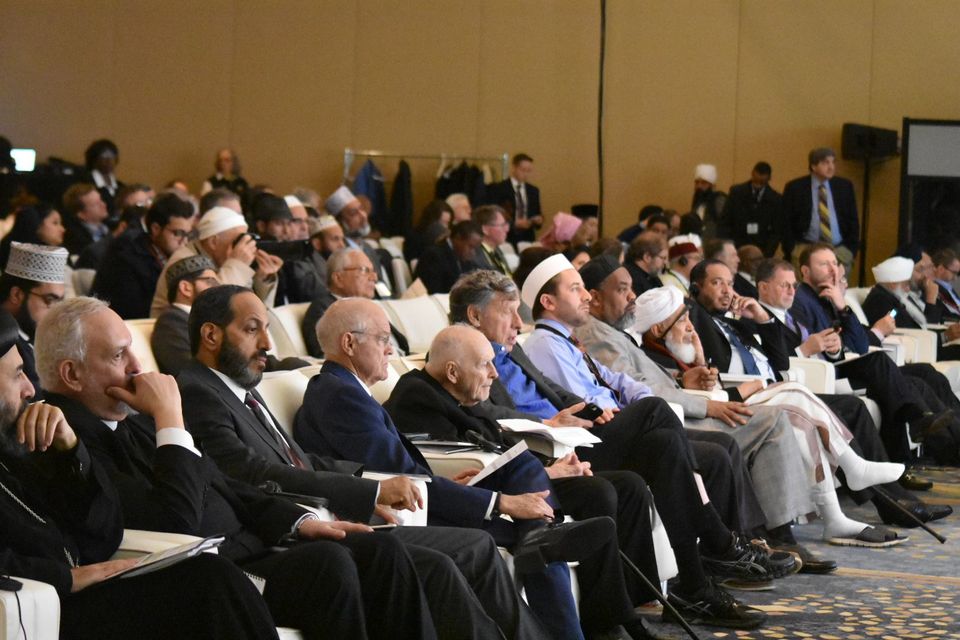Religions for Peace
Religions for Peace builds on a 50-year legacy of multi-religious engagement nuanced, informed and challenged by diverse and complex contexts at community, national, regional and global levels. Since its inception in 1970, Religions for Peace’s affiliated IRCs have engaged in a wide range of social, political, economic and humanitarian issues. As such, Religions for Peace’s multi-religious vision and engagement are built on shared values derived from both religious tenets and faith-inspired praxis.
Multi-religious leadership platform
Religions for Peace is the only international multi-religious organisation with affiliated and legally registered multi-religious leadership platforms around the world. Membership within these 90 national and 6 regional Interreligious Councils (IRCs) is built on the principle of religious representatively, reflecting the fabric of religious demography on those levels. Through these infrastructures, Religions for Peace advances common action among the world’s religious communities for a comprehensive, holistic and sustainable peace.
For Religions for Peace, peace has always been more than the absence or war or violence. Indeed, the advancement of human dignity and shared well-being, in harmony with the earth, with and through representative religious institutions and faith leadership, is at the heart of Religions for Peace’s understanding and vision of peace.
Multi-religious cooperation
Religions of Peace’s embodiment of multi-religious cooperation is a powerful way to engage the spiritual, moral and social assets of religious communities to advance shared well-being and counter the misuse of religion. It can be more powerful than the efforts of individual religious groups acting alone, more inclusive than efforts solely within religious communities, and more efficient and sustainable than ad hoc interfaith initiatives. Multi-religious engagement not only enhances knowledge of other religions, but also deepens the understanding and practice of one’s own faith.
Religions for Peace’s work is always multi-religious in nature, which includes intra- and inter-religious engagement. Four strengths distinguish Religions for Peace’s multi-religious approach.
Multi-religious Identity
Religions for Peace’s multi-religious identity is a strength when Peace initiatives are best implemented on a multi-religious basis. In these situations, multi-religious efforts can be more powerful – both symbolically and substantively – than the efforts of individual religious groups acting alone.

The symbolic strength arises when multi-religious cooperation helps to prevent or stop conflict or other challenges that can – directly or indirectly – involve different religious communities. The substantive strength arises when cooperation helps diverse religious communities to align around common challenges to Peace, offers them creative ways to take advantage of their complementary strengths, equips them for needed forms of action and – importantly – positions them for partnerships with secular institutions, without engaging those institutions in advancing particular sectarian beliefs.
Inter-religious Structures
The Religions for Peace movement refers to the entire Religions for Peace network: the World Council with its International Secretariat; 6 regional and 90 national IRCs, which also encompasses women and youth networks on these respective levels; the Global Women of Faith Network; Global Interfaith Youth Network; and their religious constituencies.
No single religious community leads Religions for Peace. Rather, representatives from diverse religious traditions working together constitute all of Religions for Peace’s structures and leadership. Its multi-religious identity helps Religions for Peace to convene and mobilise common action across many faiths.
Each interreligious body affiliated with Religions for Peace is self-led, but also part of the global Religions for Peace network. These action-oriented councils and women and youth networks are multi-religious and “public” in character. They are led by the representatives of diverse religious communities and are designed to provide a platform for cooperative action throughout the different levels within these religious communities, from grassroots to the senior-most leaders. Successful Religions for Peace bodies serve as bridges between diverse religious communities that can help build trust, reduce hostility in areas of conflict and provide a platform for common action.
How Religions for Peace operate?
Religions for Peace recognises that religious communities should be the main agents of multi-religious collaboration. Thus, Religions for Peace engages religious communities through their own representatives – leaders, outstanding persons, grassroots congregations and other organisational manifestations – in the work of building Religions for Peace-affiliated structures on every level, local to global.

A central feature of the Religions for Peace approach is its commitment to engage existing religious structures as the “building blocks” for multi-religious collaboration. Thus, multi-religious collaboration is mandated and backed by religious institutions and guided and implemented by senior-most religious leaders with community involvement. This approach has great strength insofar as it can effectively and efficiently engage religious communities’ existing strengths to build Peace through the power of collaboration. It also enables Religions for Peace to have wide reach on the grassroots level.

The method for common action developed by Religions for Peace is practical and open to continuous creativity. It assists religious communities to correlate, or work out a connection, between their capacities for action and specific challenges. The method is simple yet powerful. When applied, it discloses large, often hidden or underutilized capacities for action that lie within the reach of religious communities. Importantly, it also identifies the advantages of multi-religious cooperation and what kinds of capacity building are needed for effective multi-religious action.

Concretely, the method assists Religions for Peace to analyse specific problems; make an inventory of related religious assets and the added values of cooperation; match these with needed problem-solving roles and identify areas of capacity building essential for common action.
Religions for Peace will continue its legacy responding to the sacred call to share responsibility for the common good, care for one another, the earth, and its entire web of life.
Also read:-Christmas Celebrations: Religious Christmas Gifts
Also read:-More young adults are leaving religion, but that’s not the whole story
@religionworldin
[video_ads]
[video_ads2]












